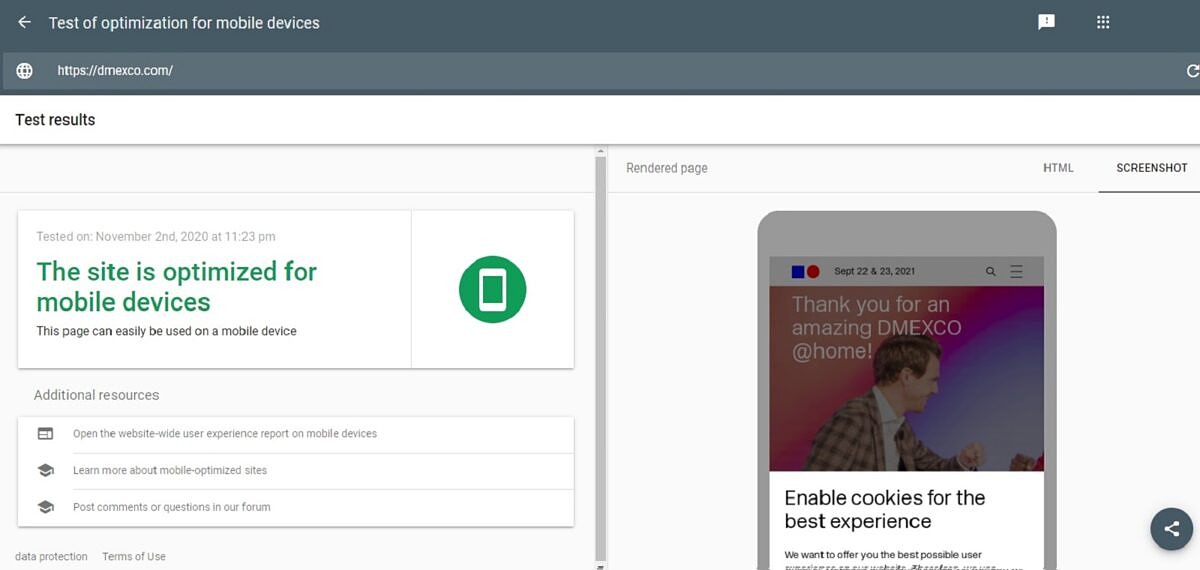Google’s mobile-first index: what webmasters need to know now
In March 2021, the final stage of the Google mobile-first indexing will come into effect. Desktop crawls will be completely stopped. So webmasters should now check whether they’re prepared for mobile crawling. Here are some vital pointers!

What is the Google mobile-first index?
As part of its mobile-first strategy, Google had originally planned to end crawling and thus the indexing of desktop sites in September 2020. However, problems experienced during testing and the unprecedented circumstances arising from the coronavirus pandemic have given webmasters a bit more time. The new standard will now take effect in March 2021 instead. So what does that mean in real terms?
For some years now, more search queries are being entered on smartphones than on desktop PCs. However, the mobile version of websites often doesn’t display the same content as the desktop version due to slower loading times. As a result, people using Google Search on mobile devices frequently get shown search results that don’t even contain the desired information in the mobile version.
For this reason, Google has been working on switching its entire technology and infrastructure to the mobile-first index since as early as 2016. Here’s a short timeline of the key stages of its implementation so far:
- On November 4, 2016, Google announced its plans to experiment with a mobile-first index.
- On December 18, 2018, the search giant started to apply the mobile-first indexing for suitable websites.
- Since July 1, 2019, mobile-first indexing has been enabled by default for all new websites, while the previous indexing standards are still being applied for older websites.
When crawling a site, Google will therefore analyze the view through the eyes of a smartphone user using the smartphone agent in the future – and thus not the desktop version like it has done up to now. The aim of this is to determine the relevance of the site for mobile users and classify it accordingly in Google’s ranking.
What are the implications of the Google mobile-first indexing for webmasters?
Since July 1, 2019, the Google mobile-first index has already been enabled by default for new websites, in other words sites that have been newly created or indexed for the first time. Google monitors and evaluates older websites on the basis of its best practice guide. If an older site has been switched to the new standard, the webmaster is notified of this in the Search Console.
In the imminent future, the mobile-first index will not be a complementary index, but rather the only one that Google uses to index websites and place them in the search engine ranking. Consequently, desktop-only websites, i.e. sites that have not been optimized for mobile use, will soon be completely disregarded by the index and no longer included in the ranking. The mobile-first index therefore basically means just one thing: a mobile-only Google!
How can webmasters meet the requirements of the Google mobile-first index?
For their websites to continue to be high up in the Google ranking, webmasters should follow the best practices that Google itself has formulated. Those who use different URLs or dynamic serving, on the other hand, will no longer even rank in search queries entered on desktops once the new standard takes effect. Only the information on the mobile version of a website will then be relevant for ranking in any type of search query.
Follow these eight steps to see if your website is ready for the switch to Google’s mobile-first indexing.
Step #1: Check the status in the Google Search Console
First check whether Google has already indexed your website using the crawler for smartphones or the one for desktops. If the smartphone crawler is already being used, Google rates your URL as mobile-friendly. Any potential errors can also be quickly identified in the Search Console. Google currently favors the responsive web design approach, in which CSS is used to automatically adapt a single version of a website to different screen sizes. In the interests of the user experience, no website should be built without a responsive design nowadays anyway.

Step #2: Ensure crawlability
Make sure that Googlebot can thoroughly crawl the mobile version of your website. For this purpose, you should use the same meta robots tags on your mobile version and desktop version and, if at all possible, avoid lazy-loading content that only loads upon user interaction. Of course, none of the resources that you want the bot to crawl should be set to “disallow”.
Step #3: Ensure identical content
The mobile website and the desktop version should have the same content. Among other things, that also includes the use of the same clear and meaningful headings arranged in an appropriate hierarchy.
Step #4: Check structured data
The mobile version of the website and the desktop version should have the same structured data.
Step #5: Provide identical metadata
The titles and meta descriptions of the mobile and desktop versions should be meaningful and identical.
Step #6: Follow the Better Ads Standards
If you display ads in the mobile version, you should follow Google’s Better Ads Standards. For example, if ads at the top of the page take up too much room, it can lead to a bad UX and consequently a poorer ranking.
Step #7: Check your images
Google has formulated best practices for incorporating images. For all images, make sure that:
- You choose the image formats that are supported by Google.
- The images on the mobile website are of the same quality as the images on the desktop version and that the resolution is not too low.
- You use the same alt text, title, labeling, and filename for images on both the mobile and desktop versions.
- The URLs do not change when the images are loaded, and you use the same image URLs for both website versions.
Step #8: Check your videos
When incorporating videos, you should follow Google’s video best practices. Make sure that:
- You only use supported video formats and put videos in supported HTML tags, e.g. object, embed, or video.
- You use the same structured video data for both the mobile and desktop version.
- You place videos on mobile sites in such a way that they are easy for users to find on their screen. If users need to scroll down a lot, it has a negative effect on the UX and thus the ranking.
- The URLs do not change when the videos are loaded.





